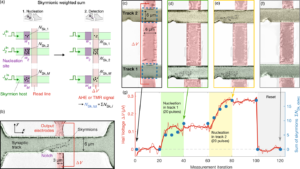 On Wednesday March 13th 2024, we have the pleasure to welcome in SPINTEC Tristan da Câmara presently at Université Catholique de Louvain la Neuve. He will give us a seminar on his work done in Lab. Albert Fert, Univ. Paris-Saclay at 14:00 entitled :
On Wednesday March 13th 2024, we have the pleasure to welcome in SPINTEC Tristan da Câmara presently at Université Catholique de Louvain la Neuve. He will give us a seminar on his work done in Lab. Albert Fert, Univ. Paris-Saclay at 14:00 entitled :
Neuromorphic weighted sum with magnetic skyrmions
Place : IRIG/SPINTEC, auditorium 445 CEA Building 10.05 (access to CEA requires an entry authorization. Request it before March 02th at admin.spintec@cea.fr)
video conference : https://univ-grenoble-alpes-fr.zoom.us/j/96132593056?pwd=V3hNUU1VRGlzaFBTamhKNWVUUFlvZz09
ID de réunion: 961 3259 3056
Code secret: 544291
Abstract : Magnetic skyrmions, which are topological magnetic solitons, boast a range of enticing features that make them promising candidates for energy-efficient computing operations [1-3], such as stability at room temperature, deep sub-micron dimensions, non-volatility, particle-like behavior, and motion at low power. These characteristics seamlessly align with the requisites of neuromorphic computing, rendering them attractive candidates for integration into neuromorphic circuits [1-5]. Recent experimental studies have shown that magnetic skyrmions can be nucleated [6-9], moved [7,9], annihilated [8] and electrically detected using the anomalous Hall effect [10] or tunneling magnetoresistance [11-12]. However, an experimental demonstration of the weighted sum operation is still missing in the context of skyrmions [4]. In our recent works [13-14], we leverage the non-volatile and particle-like characteristics of magnetic skyrmions, akin to synaptic vesicles containing neurotransmitters, to perform this weighted sum operation in a compact, biologically-inspired manner (see Fig. 1a-b). Our experimental proof of concept demonstrates a large-scale, low-energy hardware implementation of weighted sum operations based on magnetic skyrmions (see Fig. 1c-g) [13]. We demonstrate the precise electrical control of skyrmion nucleation and motion in specially designed magnetic tracks, the number of generated skyrmions being determined by the electrical pulse input multiplied by the track synaptic weight. Leveraging magneto-ionic effects to achieve non-volatile and reversible control over magnetic properties opens the door to gate voltage control of synaptic weights. Voltage gating control of magnetic anisotropy is achieved through the application of an electric field through an AlO x layer, enabling the in-plane to out-of-plane magnetic anisotropy switch in the top Co layer [14]. Detection of the number of skyrmions is accomplished through non-perturbative anomalous Hall voltage measurements. We experimentally validate the weighted sum operation using two electrical inputs in a crossbar array configuration with two tracks (see Fig. 1c-g) [13]. This ensures efficient execution of the fundamental weighted sum operation, a cornerstone for neuromorphic computing. Our experimental demonstration is scalable to accommodate multiple inputs and outputs using a crossbar array design, potentially approaching the energy efficiency observed in biological systems.

Figure 1. (a) Illustration of our skyrmionic weighted sum device, inspired from their biological counterpart using vesicles containing neurotransmitters, as depicted in the inset. Electrical inputs JIni are applied to skyrmion host tracks (in green) to nucleate controlled number of skyrmions NSk,i at nucleation sites, each with an assigned synaptic weight wi so that NSk,i = wiJIni. These skyrmions are moved into a transverse electrical detection zone, established by the intersection of the track and the read line for the electrical output (in red), where the cumulative number of skyrmions Ntot= ∑i NSk,i can be electrically detected through an output voltage ΔV arising from the anomalous Hall effect (AHE) or the tunnel magnetoresistance (TMR). (b) Kerr microscopy difference image of the device with magnetic skyrmions (dark spots), which were nucleated from a notch in a synaptic track and moved between the detection electrodes. (c-f) Kerr microscopy images of the device composed of two parallel magnetic multilayer tracks connected by a transverse Hall electrode. After the saturation of the track (c), skyrmions can be selectively nucleated in track 1 (d) and track 2 (e), before being magnetically erased (f). (g) Hall voltage ΔV (in red) and the corresponding sum of the number of detected skyrmions in both tracks ΣNSk, detec (in blue) for successive injection of skyrmion in the tracks. 20 nucleation pulses are successively applied to each track (indicated by the green and yellow areas for track 1 and 2). Figures from [13].
- [1] A. Fert, N. Reyren, and V. Cros, Nat Rev Mater 2, 17031, 2017.
- [2] G. Bourianoff et al., AIP Advances, vol. 8(5), pp. 055602, 2018.
- [3] K.M. Song et al., Nature Electronics, vol. 3.3, pp. 148-155, 2020.
- [4] J. Grollier et al., Nature Electronics 3, 360–370, 2020.
- [5] Y. Huang et al., Nanotechnology 28, 08LT02 (2017).
- [6] W. Legrand et al., Nano Letters, vol. 17, pp. 2703, 2017.
- [7] A. Hrabec et al., Nature Communications, vol. 8, pp. 1-6, 2017.
- [8] S. Woo et al., Nature Electronics, vol. 1, pp. 288-296, 2018.
- [9] S. Woo et al., Nature Materials, vol. 15, pp. 501-506, 2016.
- [10] D. Maccariello et al., Nature Nanotechnology, vol. 13, pp. 233-237, 2018.
- [11] C. Hanneken et al., Nature Nanotechnology 10, 1039–1042, 2015.
- [12] J. U. Larrañaga et al., arXiv:2308.00445, 2023.
- [13] T. da Câmara Santa Clara Gomes et al., arXiv:2310.16909, 2023.
- [14] T. da Câmara Santa Clara Gomes et al., arXiv:2310.01623, 2023.
Biography : Tristan da Câmara Santa Clara Gomes is a Postdoctoral researcher at the Université Catholique de Louvain. He holds a PhD in Engineering and Technology from Université Catholique de Louvain, with his dissertation titled “3D Interconnected Magnetic Nanowire Networks.” He continued his research with a postdoctoral project at the same institution, focusing on the fabrication and characterization of flexible, lightweight thermoelectric and spin caloritronics devices based on large-area 3D interconnected nanowire network films. Following this, he joined the Unité Mixte CNRS-Thales, Université Paris-Saclay for another postdoctoral project dedicated to neuromorphic computing devices, utilizing the electrical control and detection of magnetic skyrmions. Currently, he is back at Université Catholique de Louvain, dedicated to exploring the potential of 3D nanowire networks and their exceptional interconnectivity for unconventional computing applications.




